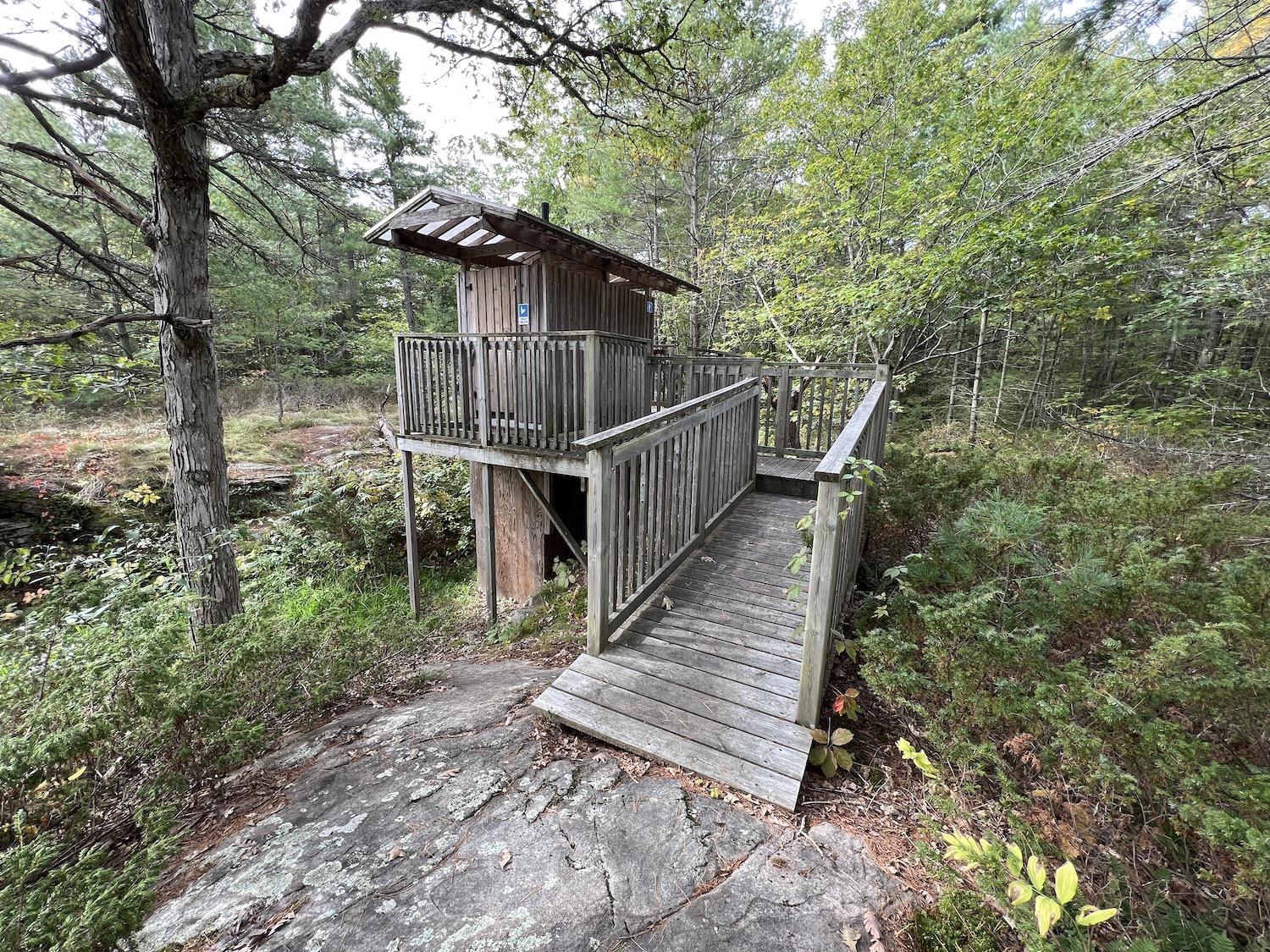
The treehouse-style outhouses at Georgian Bay Islands National Park stand out among Parks Canada's public toilets/Jennifer Bain
Call them what you like — outhouses, pit privies, vault toilets, washrooms, bathrooms or just plain old public toilets. When you spend the year touring Parks Canada's national historic sites and national parks for stories — like I just did — you'll need to use the facilities on a regular basis. And by facilities, I don't mean the "facilitrees" when you're desparate and have to go in the great outdoors, and I don't mean the cush indoor ones with flush toilets found in heated/air-conditioned visitor centers. I mean the stand-alone ones that aren't always as clean and fragrant as you'd like and where you consider yourself lucky if there's a good supply of toilet paper and sanitizer.
I always snap a photo of where I've gone to the loo and often post the shots on social media as part of a sporadic "bathrooms around the world" series. As 2022 draws to a close, I decided to compile my images into a feature that also lets me revisit the stories that drew me to each park and site in the first place. Without further ado, and in no particular order, here are some random thoughts on my year in public toilets.
Georgian Bay Islands National Park (Ontario)
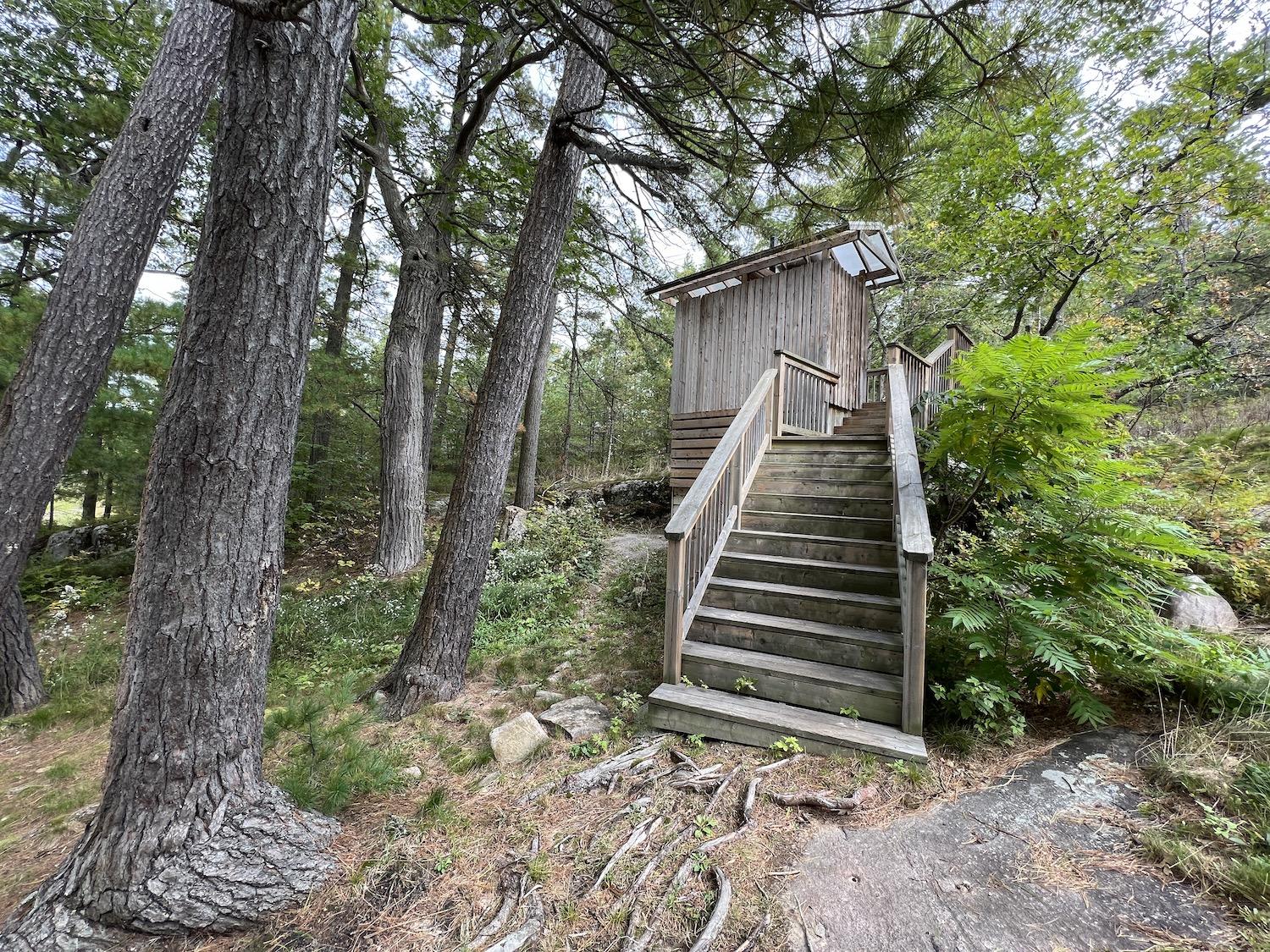
Another two-level outhouse at Georgian Bay Islands National Park in Ontario/Jennifer Bain
They look like treehouses but they’re actually two-storey composting toilets. The top level is where you do your business, and the bottom level is where Parks Canada staff does their bit to manage human waste. These wooden outhouses on Beausoleil Island have “turned yellow and faded into the background so well,” says Andrew Promaine, the resource conservation manager who led the charge to convert from pit toilets to composting toilets more than a decade ago. Some of these structures are accessed from the second level, but some are less accessible and involve stairs. There’s even one on the mainland where you catch the park’s DayTripper boat shuttle. I was drawn here for an island getaway not far from my home in Toronto.
Kluane National Park and Reserve (Yukon)
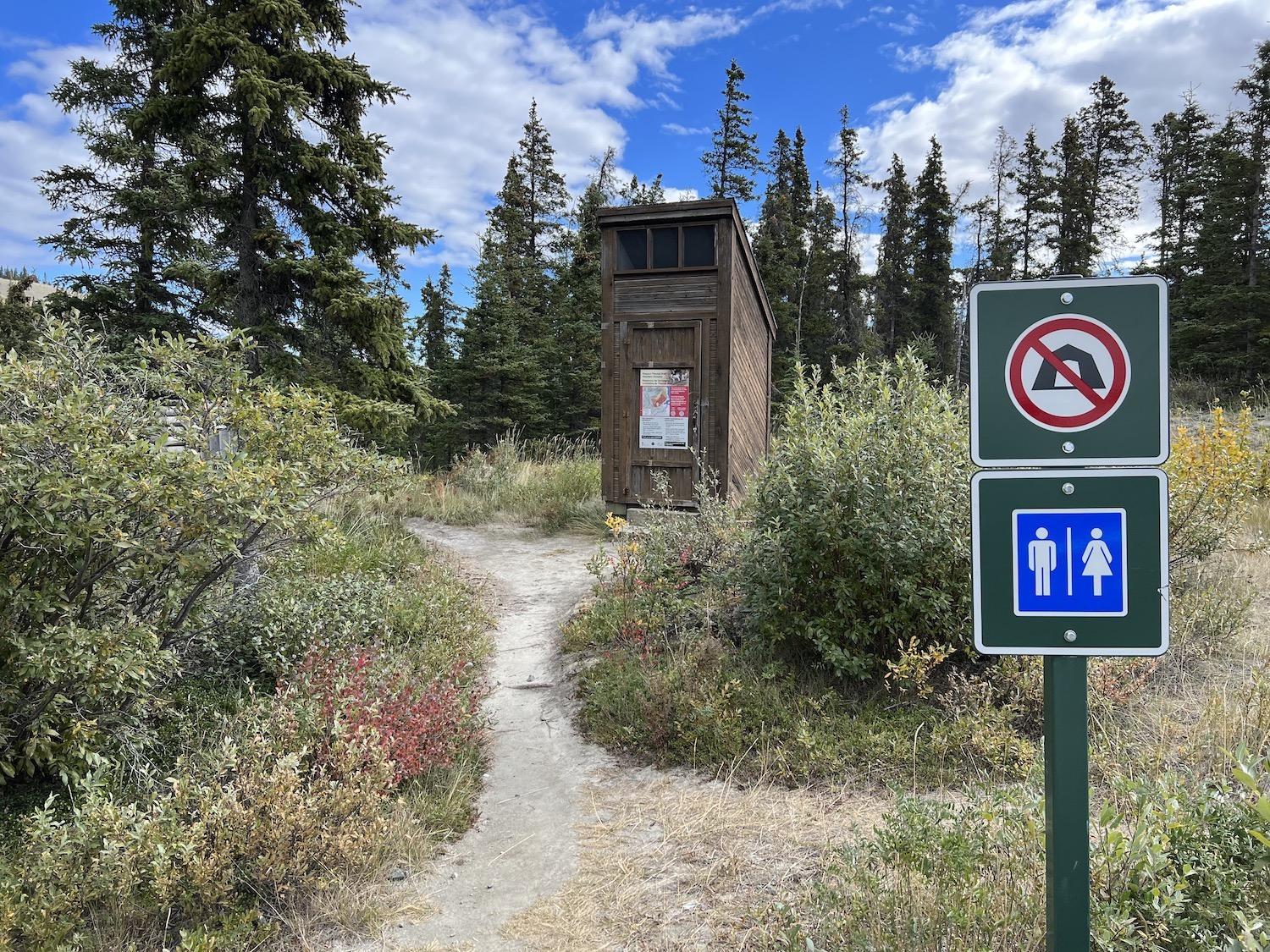
An outhouse near Sheep Creek Trail in Kluane National Park and Reserve in the Yukon/Jennifer Bain
There were three public toilets of note in Kluane — the pretty one at Kathleen Lake (detailed at the end of this story) where I fished, the one with stunning mountain views outside the Thechàl Dhâl' Visitor Centre where I learned about Dall's sheep, and this old school outhouse near the parking lot that leads to the trailhead for Sheep Creek, West, Canada Creek and Bullion Plateau trails. I'm super literal and so love how it’s behind a “no camping” sign (as if someone would pitch a tent beside a toilet), and how the front is dominated by a sign asking people to respect voluntary closures that protect Dall’s sheep. Inside, this weather-beaten outhouse reminds me of the one at my family cottage in the 1970s before we got a septic tank and moved things indoors. Instead of a toilet, there’s just a toilet seat built into a wooden platform.
Kouchibouguac National Park (New Brunswick)
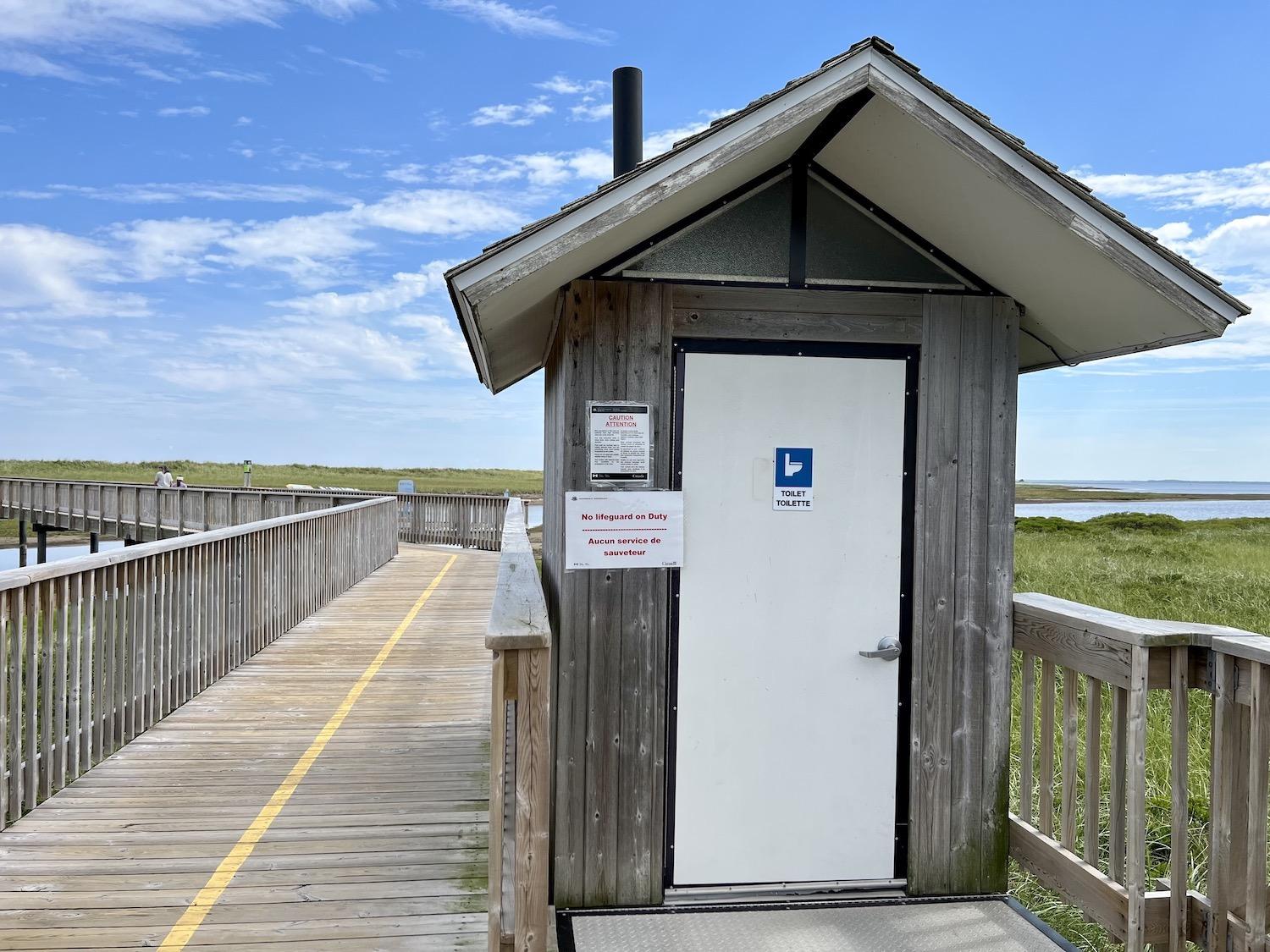
This outhouse is on a boardwalk in Kouchibouguac National Park in New Brunswick/Jennifer Bain
Parks Canada says the 1.2-kilometre (0.8-mile) boardwalk to Kellys Beach is “without a doubt the most travelled trail” in Kouchibouguac. It leads people across a salt marsh, over lagoons and past sand dunes to the beach and Atlantic Ocean. I knew to expect interpretive signage along the way, but but was delighted to find an outhouse built right into the boardwalk. One temporary sign on the outside while I was there in June warned of the Avian flu killing birds. Another sign gave fair warning that there was no lifeguard on duty (presumably meaning at the beach, not for outhouse users). I wasn't there to swim — just to visit Canada's largest tern colony and learn about and Mi'kmaq history.
Grasslands National Park, East Block (Saskatchewan)
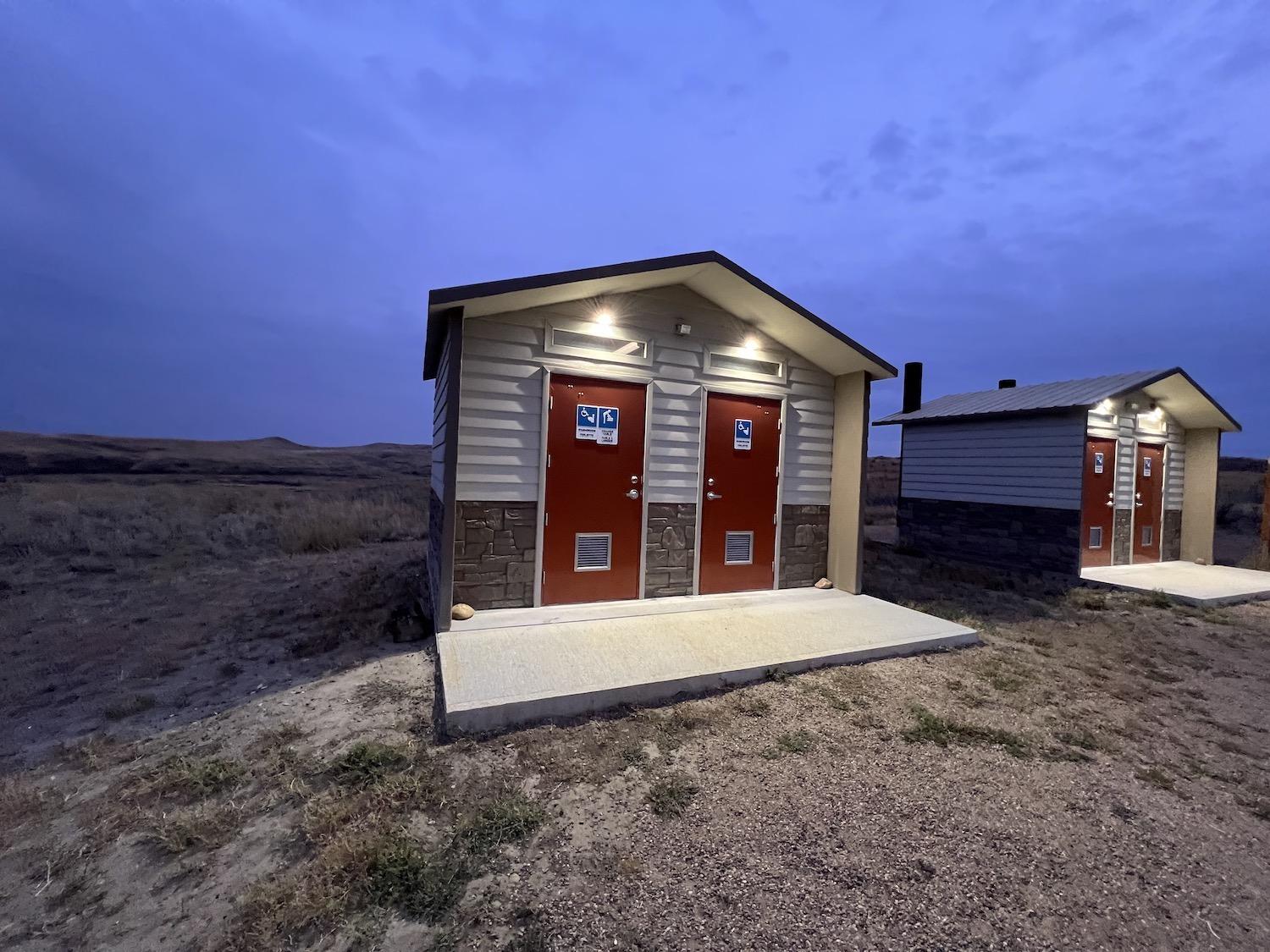
There are motion-sensor lights at these campground toilets in the East Block of Grasslands National Park in Saskatchewan/Jennifer Bain
I’m admittedly not much of a camper, mostly because I go to the bathroom several times a night and don't like schlepping around outside in the dark. But when my sister-in-law Jennifer and I spent a night comfort camping in an oTENTik (an A-frame cabin/tent hybrid) in Rock Creek Campground in the East Block of Grasslands, I was grateful that it had “easy access to vault toilets” as promised. Granted, I picked spot RC32, right beside the toilets. But it was just 15 steps away, came with a vault toilet, urinal, mirror and sanitizer, and had motion-sensor lights at night so I didn't even need a flashlight. By day, we hiked the memorable Valley of 1000 Devils trail — twice.
Boishébert and Beaubears Island Shipbuilding National Historic Sites (N.B.)
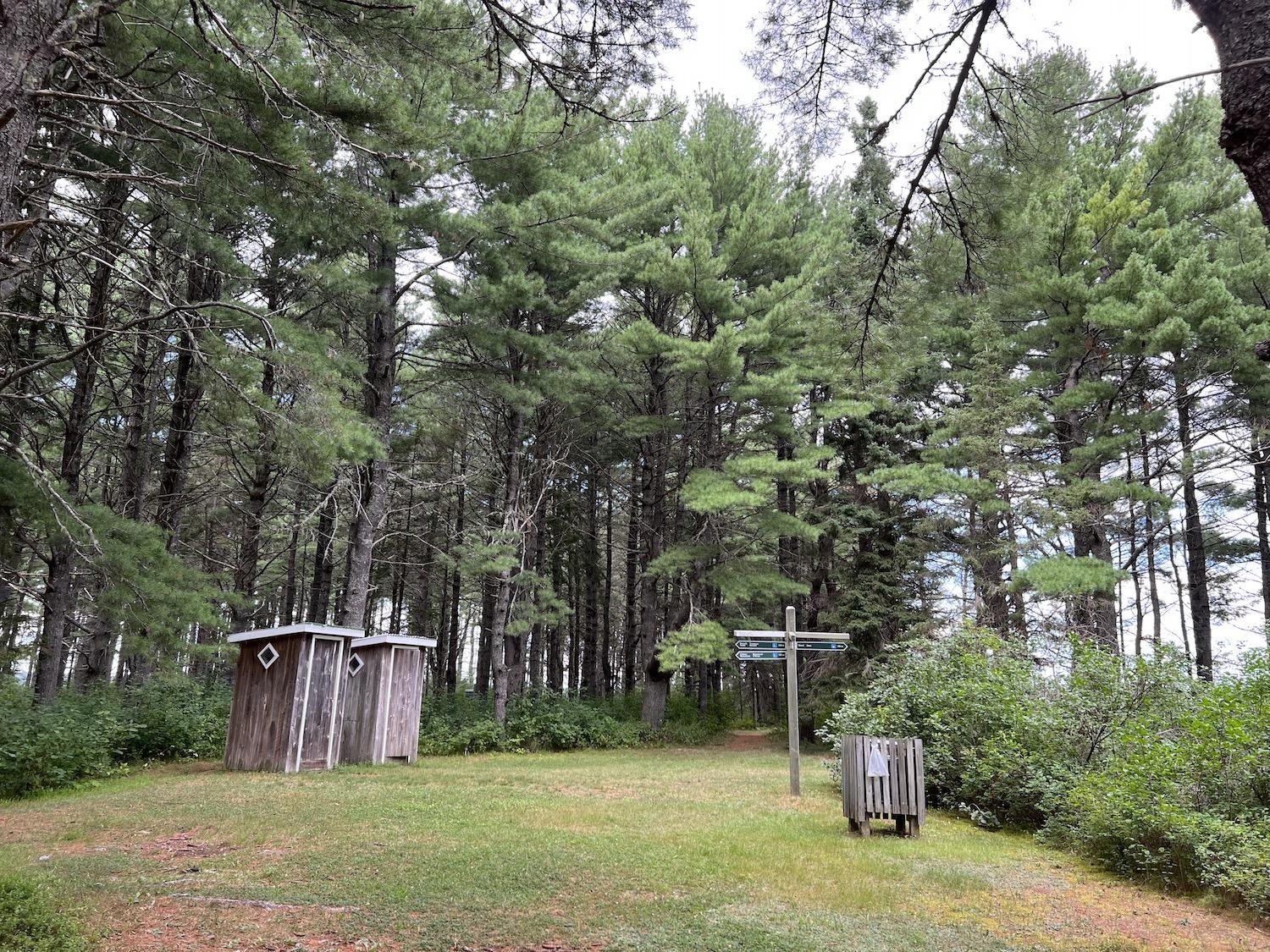
At Boishébert and Beaubears Island Shipbuilding National Historic Sites in New Brunswick, there is minimal infrastructure/Jennifer Bain
Sometimes less is more. In the Beaubears Island Shipbuilding area of this two-for-one site, there’s almost no infrastructure and so visitors are mainly left to explore the network of hiking trails on this small, densely forested island on their own. I was lucky enough to have two guides from the Friends of Beaubears Island who pointed out the seasonal dock, a few scattered benches, Parks Canada’s signature red Adirondack chairs, sporadic signs, ruins and these tasteful outhouses. Nestled discreetly among the pine trees, these fetching wooden buildings with white trim boast small square windows that have been cleverly rotated to look like diamonds.
Fundy National Park (N.B.)
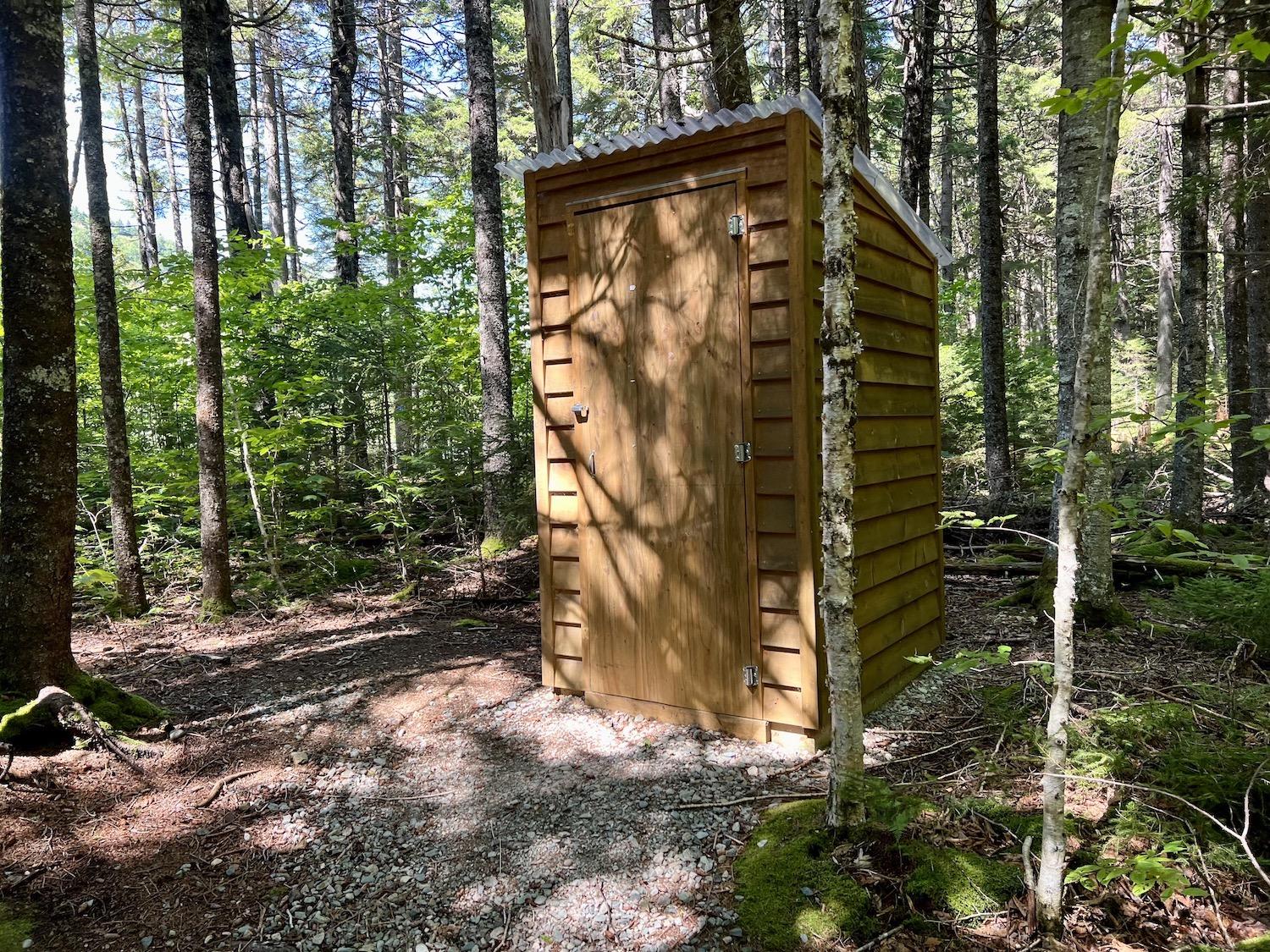
This outhouse is at Black Hole along the Upper Salmon River trail in Fundy National Park in New Brunswick/Jennifer Bain
When I went out with Parks Canada researchers to check on the endangered Atlantic salmon at “Black Hole” in the Upper Salmon River, they drove me down the off-limits back roads to save time before we went snorkelling. Regular visitors pass by the same spot by hiking the 8.2-kilometre (5-mile) Upper Salmon River Trail. I can only imagine what a relief it must be to find this remote, no fuss outhouse with a plastic roof panel on a lengthy journey. I still feel bad for making the snug interior temporarily wet as a I struggled to get out of my drysuit.
Fort Rodd Hill and Fisgard Lighthouse National Historic Sites (British Columbia)
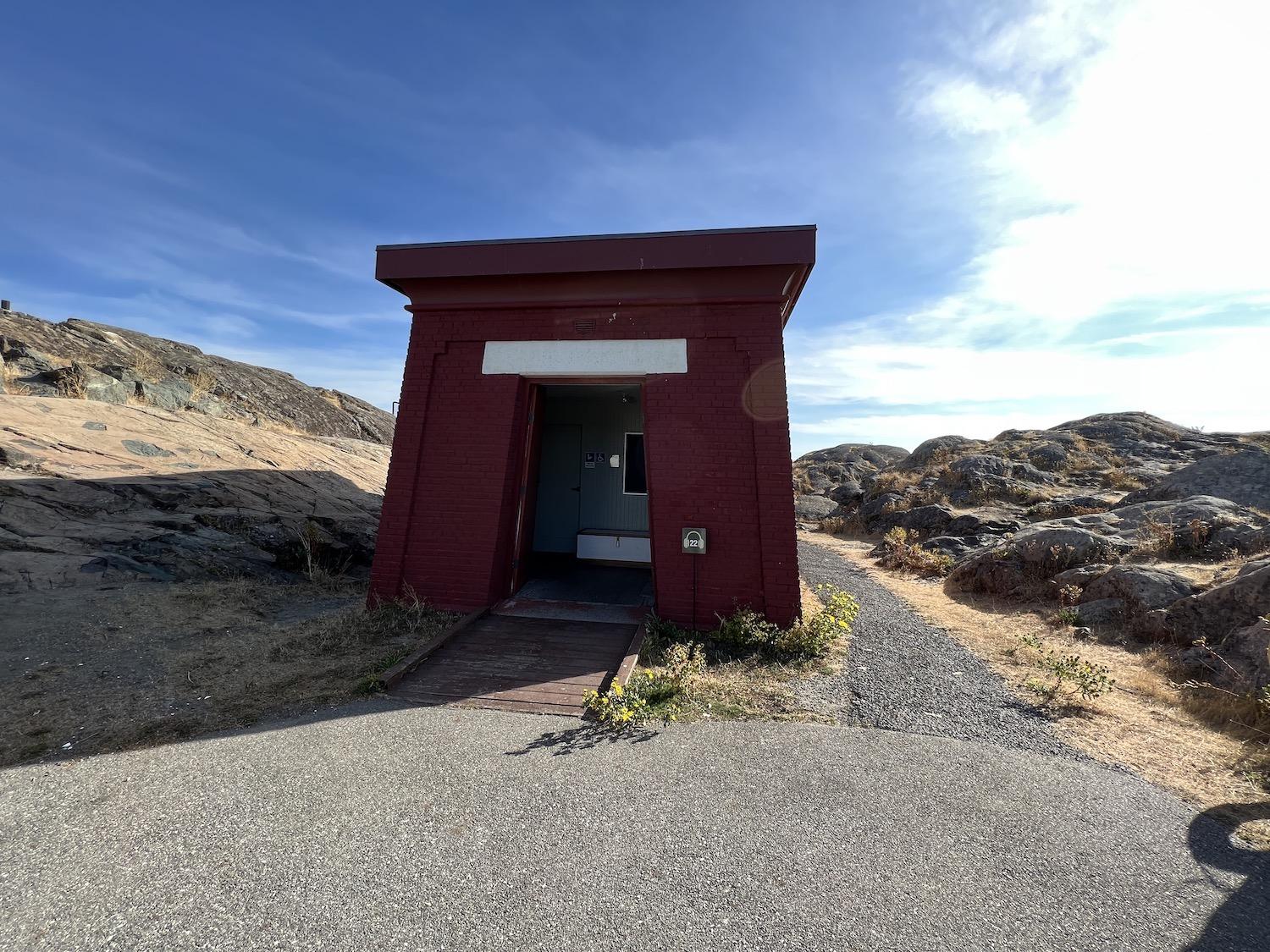
This public toilet features a splash of red at Fort Rodd Hill and Fisgard Lighthouse National Historic Sites/Jennifer Bain
At the Fisgard Lighthouse portion of this Vancovuer Island site with military, navigation and nature stories to tell, this washroom has a more robust exterior than most and was clearly built to withstand battering from the ocean winds. But what jumped out at me was the fact the brick building looks a bit like the bottom of a lighthouse and is painted a deep shade of red — one of Parks Canada’s colors — presumably to blend in with the popular 1860 lighthouse, the oldest one on Canada's west coast. In a cross-country sea of wooden outhouses, this one is memorable for its welcome splash of color.
Gulf Islands National Park Reserve (B.C.)
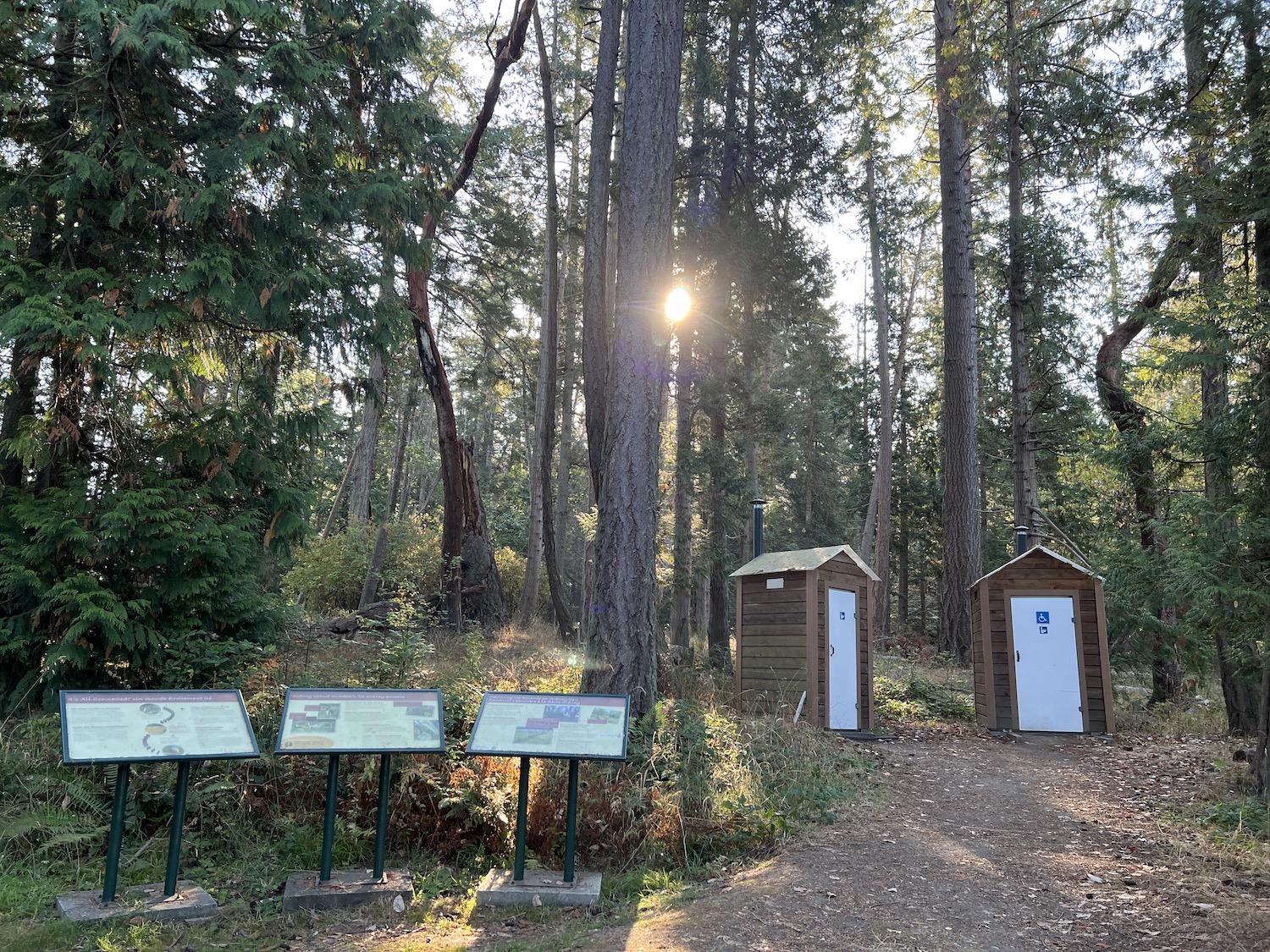
There's plenty to read if you're waiting for someone to use the loo at Sidney Spit in Gulf Islands National Park Reserve in British Columbia/Jennifer Bain
An island called Sidney Spit, part of Gulf Islands National Park Reserve, is a short summer passenger ferry ride from the town of Sidney on Vancouver Island. Not far from the ferry dock, I checked out these two simple outhouses with vault toilets in the forest. Usually there’s no reason to linger, but three interpretive signs with lots to say have been placed near these public toilets. Inside, I was struck by a notice stapled to the wall that said: “Please do not use the pit toilet for the disposal of sanitary products, bags of dog waste or any other garbage.” I think that means dog owners can put doggy doo here but not the bags they collect it in, even if they're compostable or biodegradable. This unusual park reserve doesn't have a visitor center to pull things together, and is spread out over multiple islands, each with different personalities, making it a challenge to write about.
Grasslands National Park, West Block (Saskatchewan)
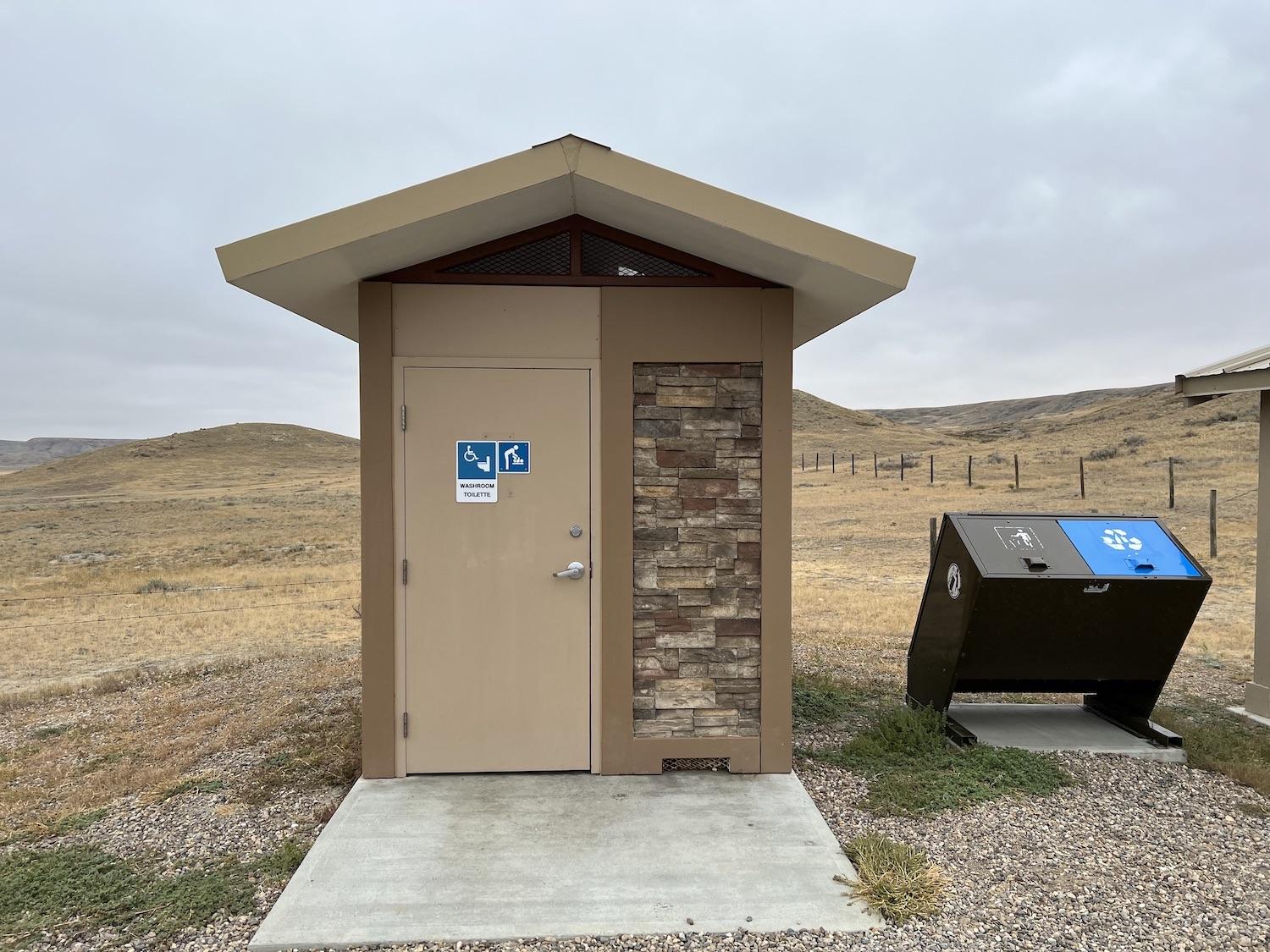
Stone is artfully worked into this outhouse in the West Block of Grasslands National Park/Jennifer Bain
In the West Block of Grasslands National Park — which is about 2.5 hours away from the entirely separate East Block — I explored 70 Mile Butte with a wildlife ecologist looking in vain for endangered Greater Short-horned Lizards just as summer turned to fall. But I remember this outhouse because it had a mirror and baby-changing table inside plus a nice rock feature on the outside that blended in with the nearby bearpaw shale and the color scheme of the mixed-grass prairie ecosystem.
Kejimkujik National Park and National Historic Site (Nova Scotia)
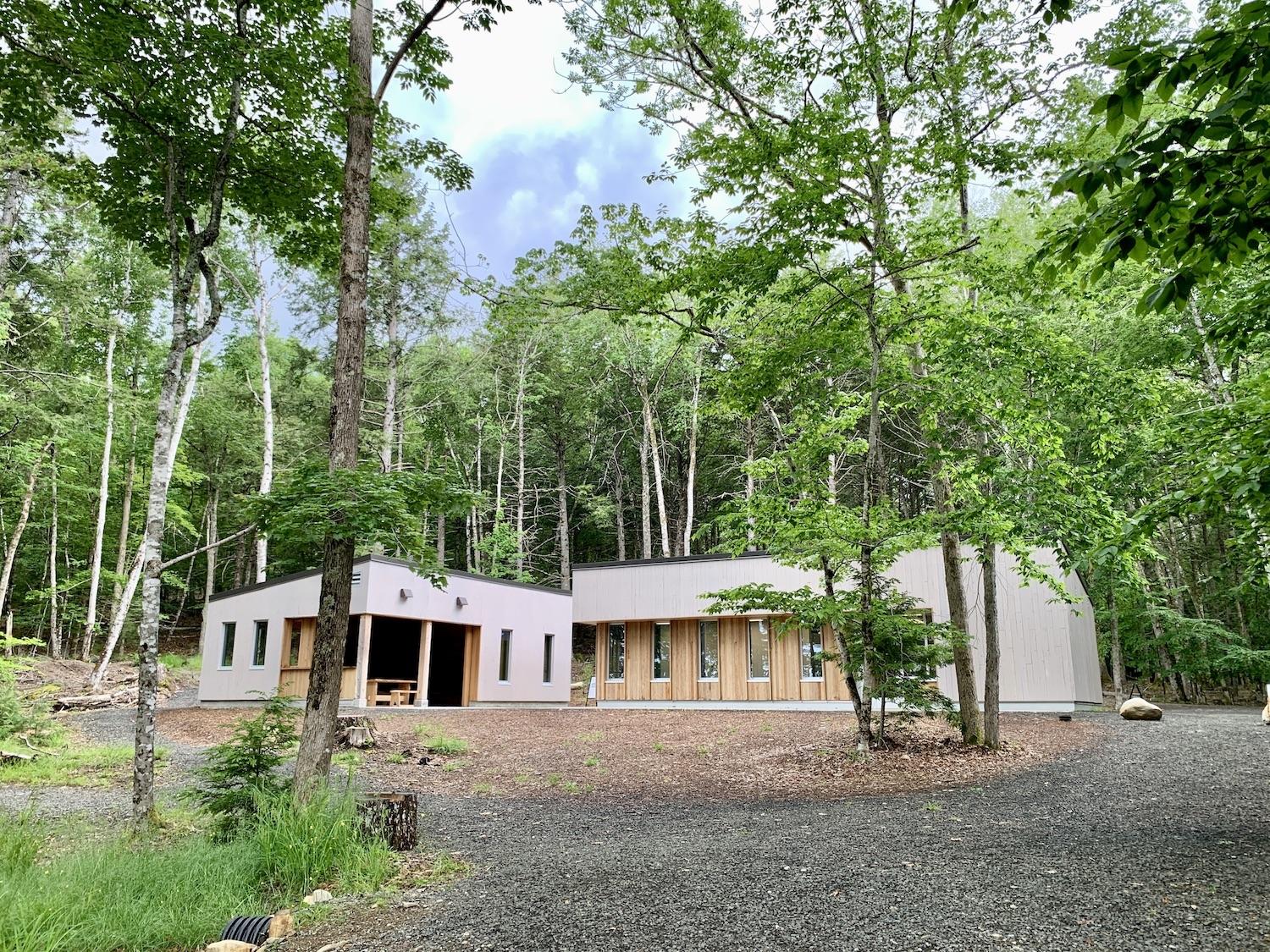
The most dazzling campground washroom and shower facilities are at Kejimkujik National Park and National Historic Site in Nova Scotia/Jennifer Bain
It almost feels like cheating to include the universal-access, gender-neutral washrooms and shower facilities at Jeremy Bay Campground because they are so new and dazzling. But Kejimkujik has set the bar for what we should expect to slowly roll out across the country. Each washroom building holds five private, gender-neutral bathrooms that have lockable doors plus their own toilets, sinks and grooming areas. One bathroom in each building is barrier free, and one is designated for families. Each building boasts three showers, including one that is barrier free. Despite the razzle dazzle, I’ll admit to sometimes opting for the simple vault toilet that was closer to my oTENTik, with a toilet seat built into a wooden seating platform. When I wasn't geeking out on toilets at this park, I was learning about Mi'kmaq history and invasive Hemlock Woolly Adelgids.
Georges Island National Historic Site (N.S.)
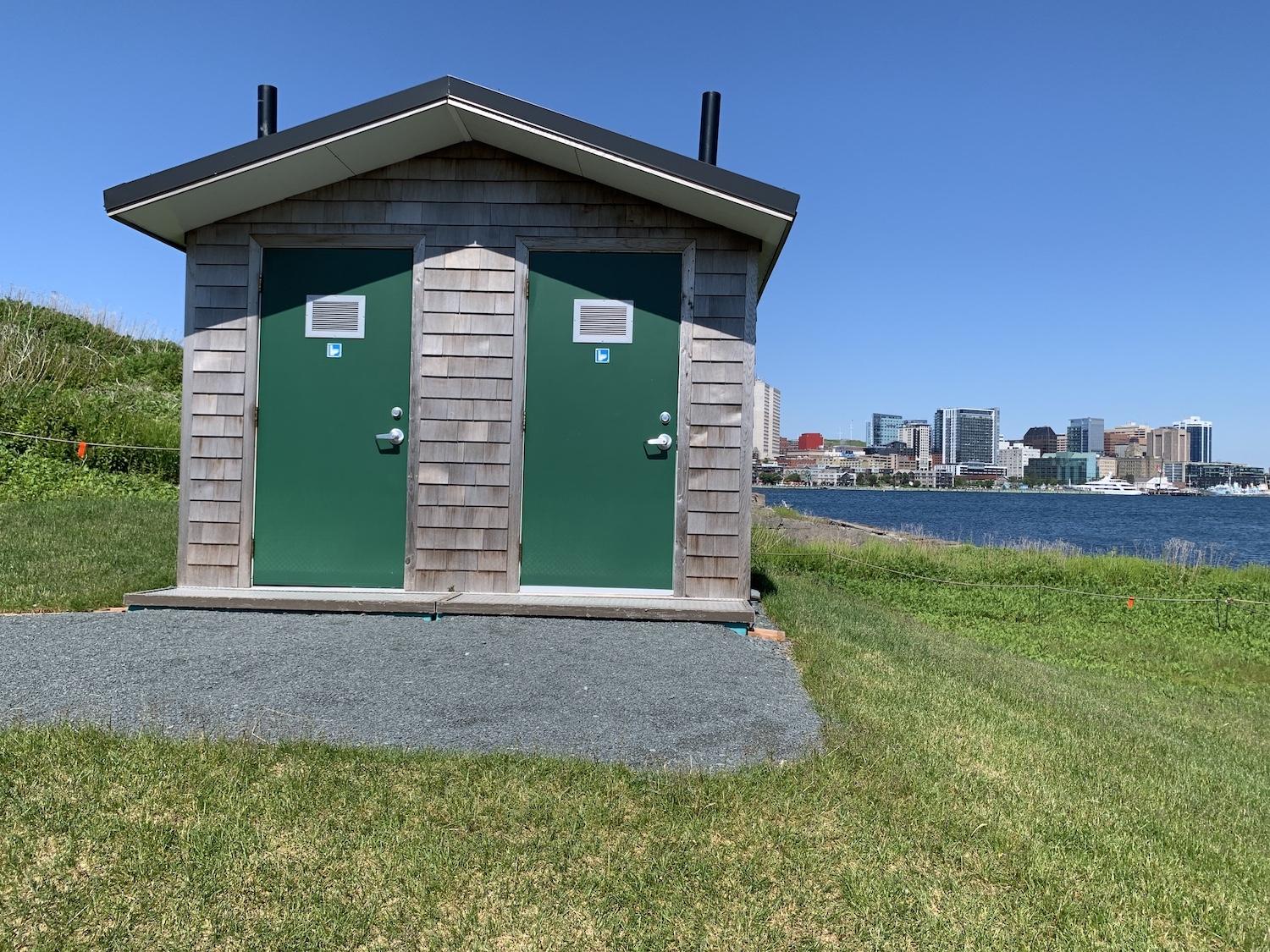
Loos with an urban view at Georges Island National Historic Site in Halifax/Jennifer Bain
In the travel writing circles that I belong to, people constantly show off photos of the views from their hotel rooms around the world. In that spirit, I offer the view of downtown Halifax from this public toilet at Georges Island. The site — one of five spots in the Halifax Defence Complex — only became accessible to the public in 2020 after Parks Canada installed a wharf, so this two-unit washroom is about as modern as they come. Wood shingle siding, a solid roof and real doors (with actual locks instead of hooks or sliding latches) stand out, as do the doors that have been painted a tasteful shade of Parks Canada green.
Prince Edward Island National Park (P.E.I.)
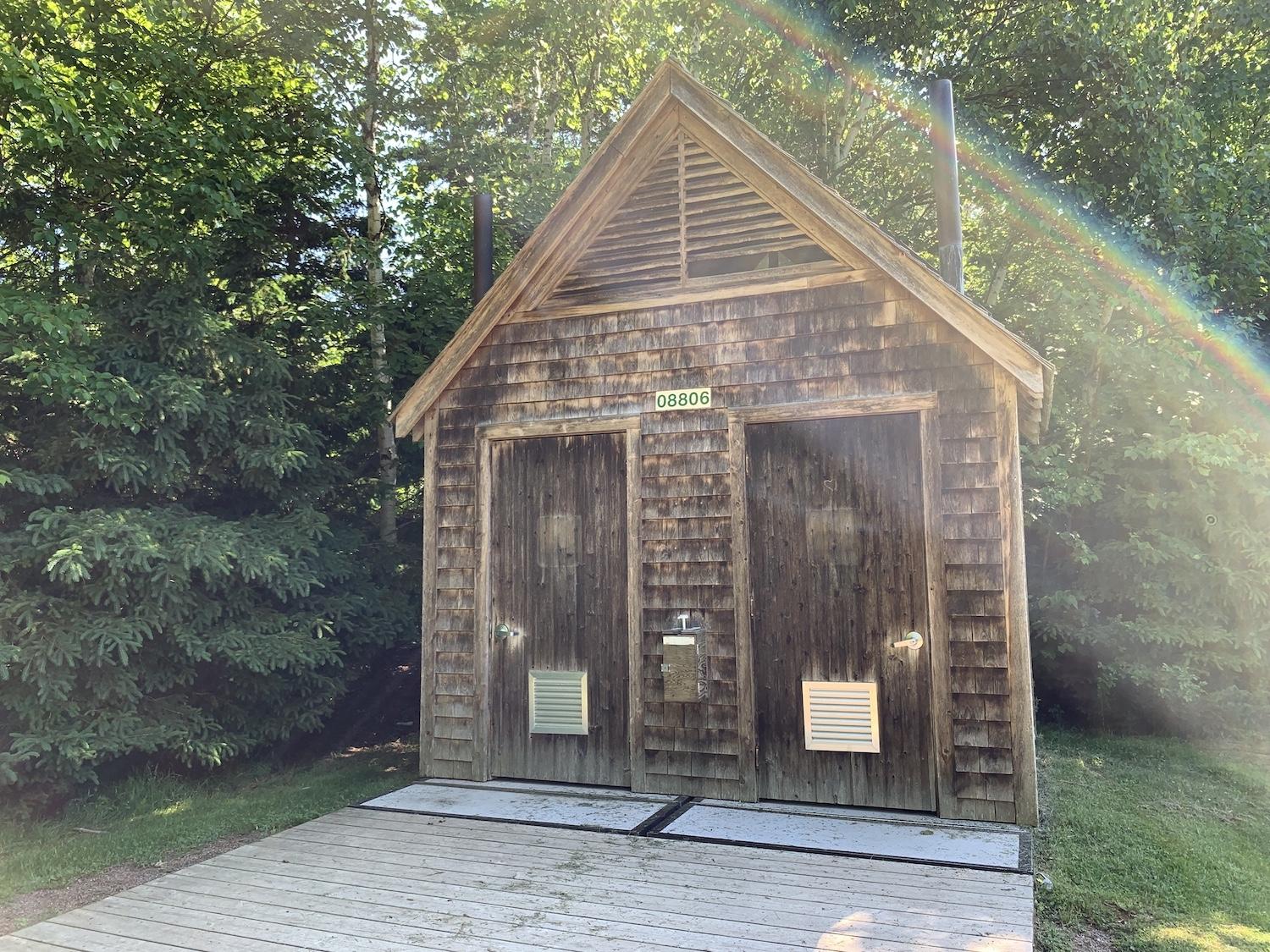
A decidedly retro outhouse with a Swiss vibe at Prince Edward Island National Park/Jennifer Bain
It’s admittedly off topic to say that when I comfort camped at the Brackley-Dalvay section of this park, I was grateful for the coin washers and driers in the campground washroom building after I explored the sandy dunes in a downpour and needed to do my laundry. As I continued dune explorations at the park's Greenwich section, I found this unusual outhouse on the Havre Saint Pierre Trail. The architecture seems vaguely Swiss with its extra-high pointed roof, and there’s a cabinet between the two doors that holds a jug of hand sanitizer. Inside, a sign explains that this recycling toilet doesn't use water or chemicals. “Waste is being composted in the equipment below the building,” the sign says. “DO NOT throw cigarettes, plastic, bottles or cans into this recycling toilet. Please close the cover after using toilet.”
Grand-Pré National Historic Site (N.S.)
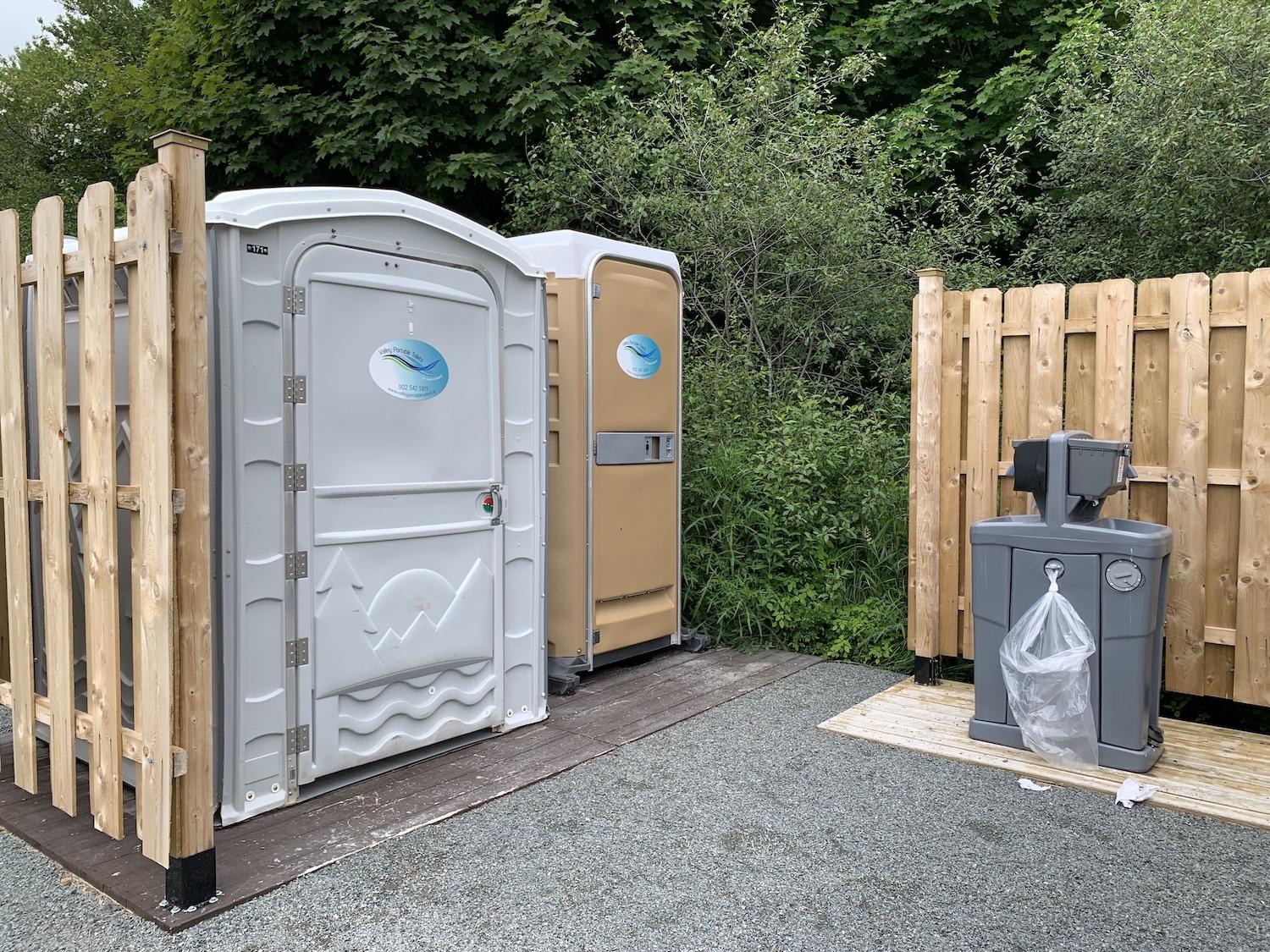
A different kind of washroom offering for campers who stay at Grand-Pré National Historic Site in Nova Scotia/Jennifer Bain
It’s still uncommon to be able to camp at national historic sites, given the fact most are quite small. But Grand-Pré boasts eight fairly new oTENTiks (a cross between a tent and a rustic cabin with a wooden frame, canvas covering and wood floor). Campers can use washroom and shower facilities in the visitor information center but also have access to portable toilets — rented from a nearby Nova Scotia company — and hand-washing stations. There are plans for more permanent infrastructure closer to the oTENTiks, which aren't far from the famous Evangeline statue that helps tell the Acadian deportation story.
Batoche National Historic Site (Saskatchewan)
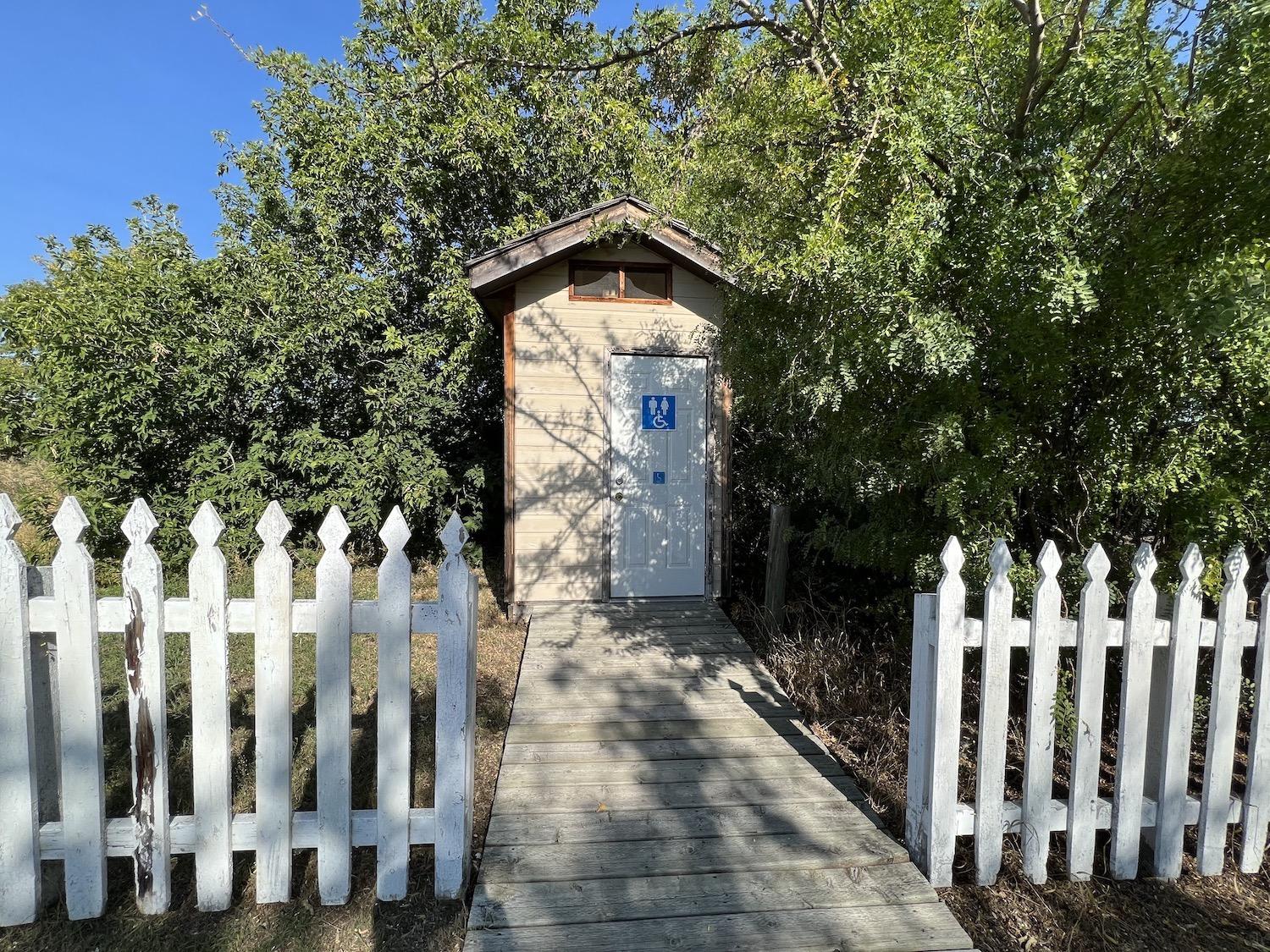
There's a faded but lovely white picket fence by this outhouse at Batoche National Historic Site/Jennifer Bain
This outhouse isn’t much to speak of visually (I don't love how the white door clashes with the beige siding), but the fact that it’s tucked behind a white picket fence makes all the difference to the overall homey vibe. Technically the fence starts at the Saint Antoine de Padoue Church, rectory and garden and continues past the outhouse. Elsewhere at Batoche, the spiritual capital for the Saskatchewan Métis, there’s a newer outhouse near the visitor center that’s a two-tone grey with corrugated galvanized steel panel, and a tasteful one at the East Village with newish wood panels that haven't weathered too much yet. When you start studying photos of outhouses across Canada, you'll see how their shape, building materials and colors change ever so slightly, although there's never any indication of when each was built.
Pacific Rim National Park Reserve (B.C.)
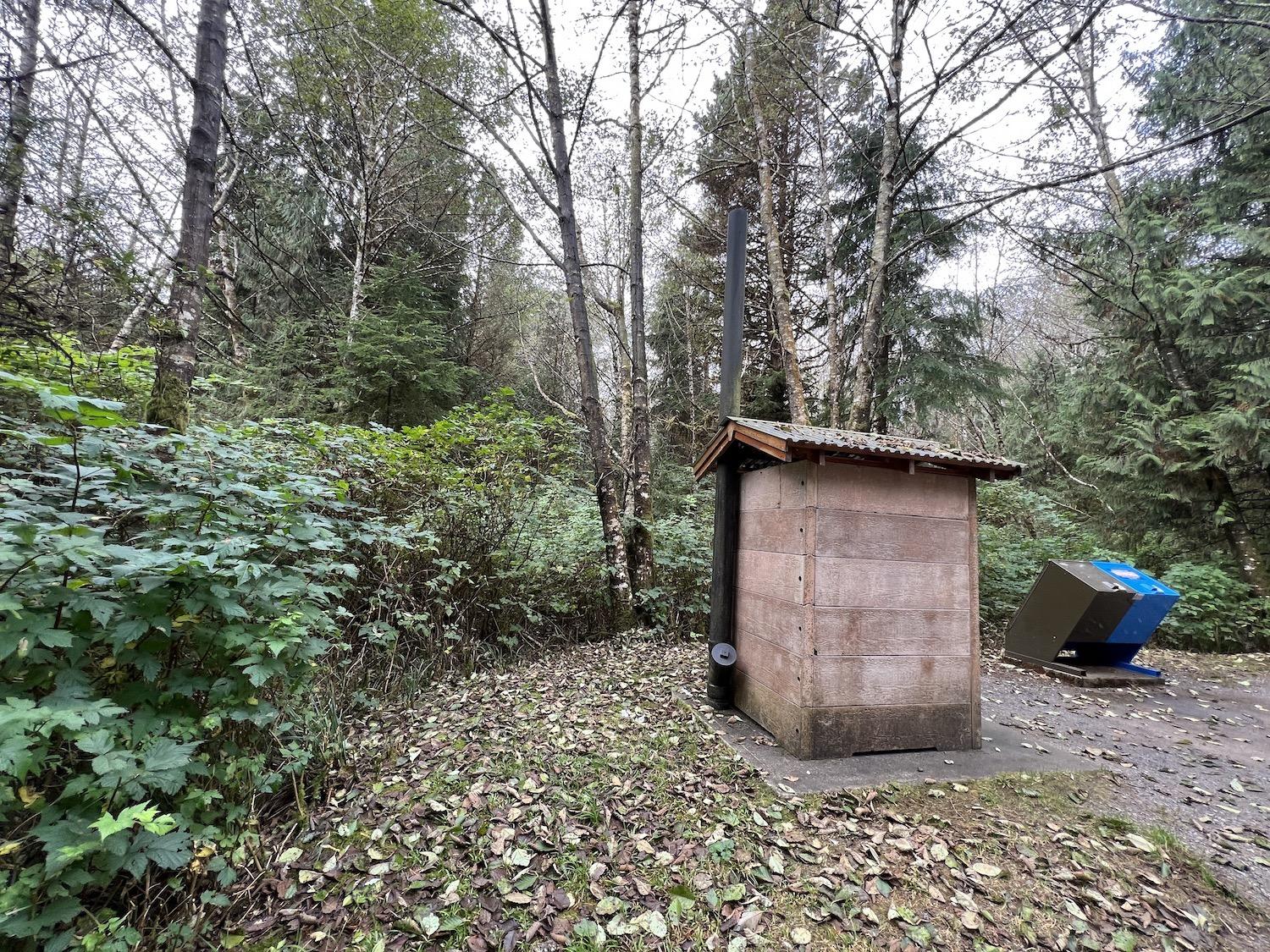
An unassuming loo at Pacific Rim National Park Reserve reminds us that somebody has to clean these things/Jennifer Bain
There were plenty of public toilet options when I e-biked down the ʔapsčiik t̓ašii (ups-cheek ta-shee) multi-use pathway, but this one at the parking lot for the Rainforest Trails stood out. The front was innocuous, with a nice wood door and a sign that said it was meant for women. Inside was a vault toilet and another of those signs imploring ill-mannered people not to put garbage down the outhouses. Animal-proof garbage and recycling bins stood strategically between the men’s and women’s outhouses. What struck me, though, was the extremely visible black tube behind the outhouse that reminds us that some unsung heroes have messy, unpleasant jobs to do.
Kluane National Park and Reserve (Yukon)
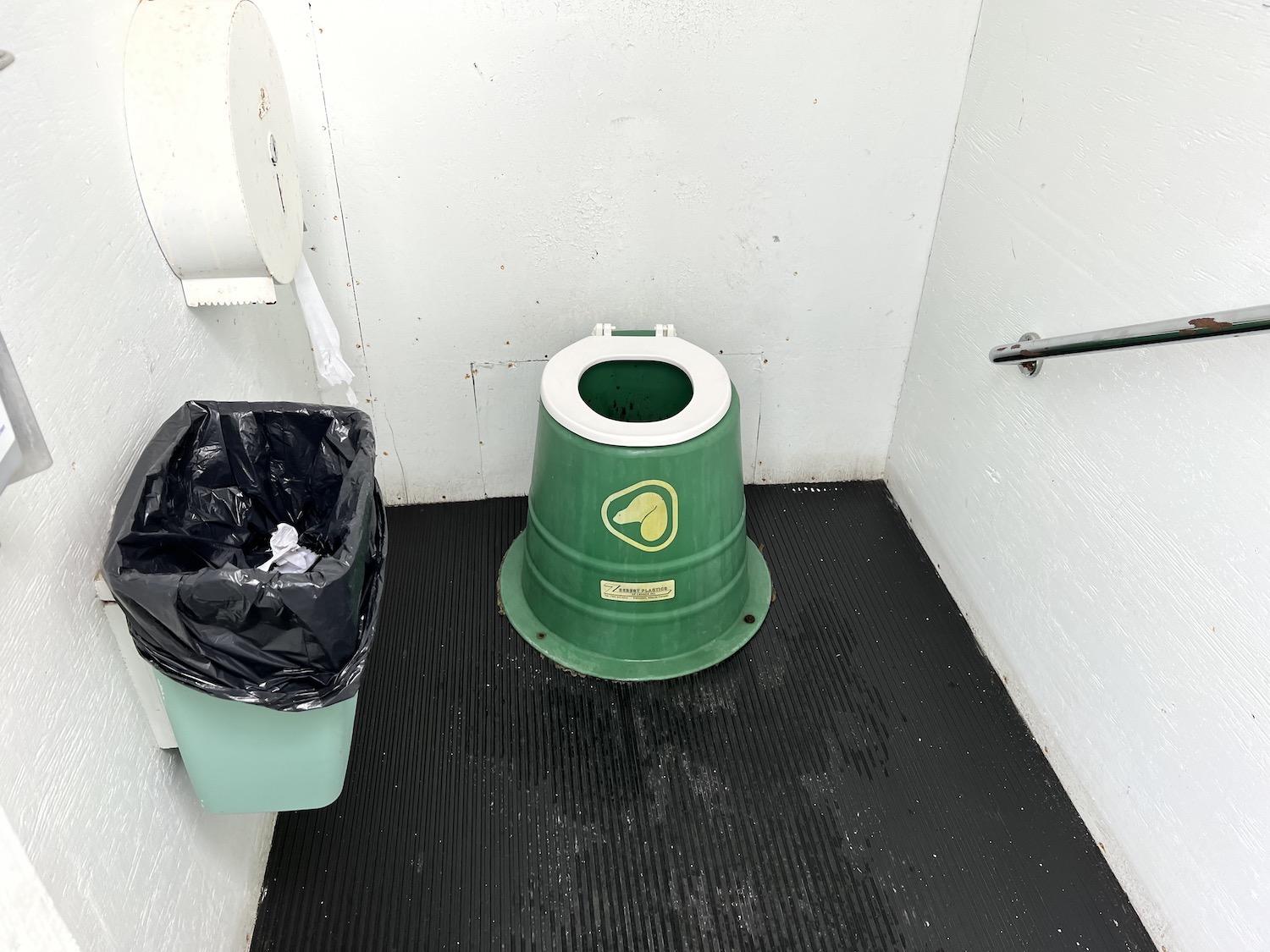
An old Parks Canada branded toilet in an outhouse at Kathleen Lake in Kluane National Park and Reserve/Jennifer Bain
I haven’t delved too deeply into the actual toilets I used in 2022 because most were white and inconsequential. But the ones in a pair of classic wooden outhouses at Kathleen Lake (Mät’àtäna Män), where I fished for Arctic grayling and lake trout, were faded corporate green. One of them even says "Parks Canada" and shows the federal agency’s signature beaver logo. A relic worth preserving, to be sure. To end this roundup with a more pleasant image, though, I offer the exterior shot of the same outhouses — one larger and sporting an accessible sign — nestled among the early fall foliage.
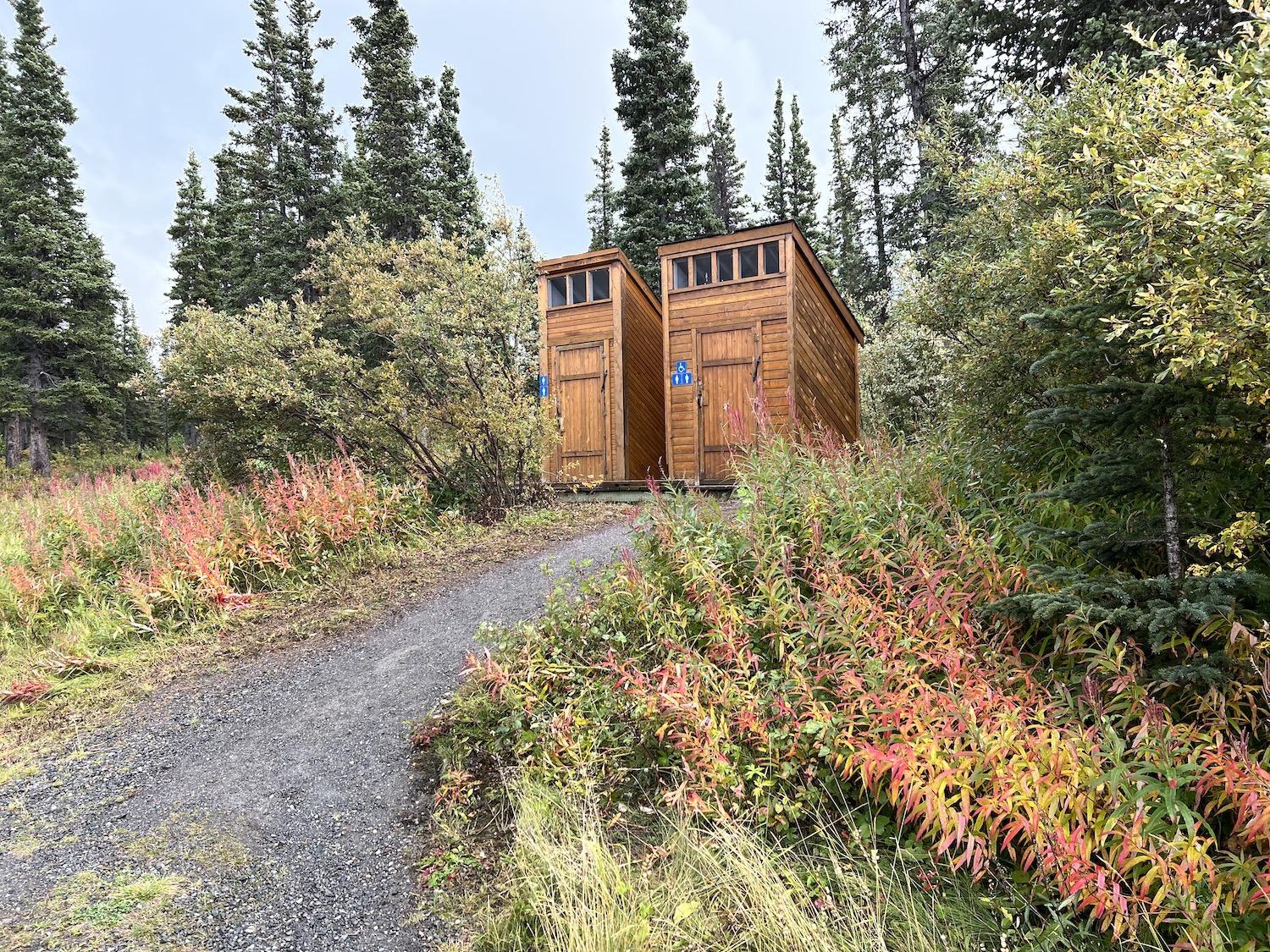
Gorgeous fall foliage surrounds the outhouses at Kathleen Lake at Kluane National Park and Reserve/Jennifer Bain
A word from Parks Canada:
On a final and more serious note, Parks Canada couldn’t speak to outhouse architecture and design but says that proper management of human waste protects visitors, the environment and the ecological integrity of national parks, marine conservation areas and historic sites.
It operates about 1,300 toilets, ranging from simple pit privies to large scale, multiple-unit flush toilet buildings connected to local septic fields or to municipal-scale wastewater treatment systems. It has also assessed various alternative toilet systems, and operational teams can choose from a variety of options for the most effective and lowest-impact management of human waste.
Each Parks Canada site gets to pick its own human waste management system, taking into account requirements such as:
- Availability and/or feasibility of water and sewage infrastructure.
- Road access.
The number of visitors and intensity of visitor use (length of stay, typical group sizes, etc.), and how visitors move through the landscape and where they stop to camp.
- The topography, substrate, elevation and unique or sensitive habitats.
- Health and safety, cost, environmental, archaeological aspects and technical aspects.
Very roughly, Parks Canada estimates that toilet systems may cost anywhere from $10,000 ($7,400 USD) to more than $1 million ($738,000 USD). But only 20 to 30 per cent of toilet systems are in use year-round, although this estimate is based on operational experience and not on hard data, as this isn’t tracked nationally for either plumbed toilet systems or alternative toilet systems.
The federal agency had more to say (in a written statement) on the nuances of its human waste management systems, and I hope to dig deeper into this fascinating subject in 2023.


